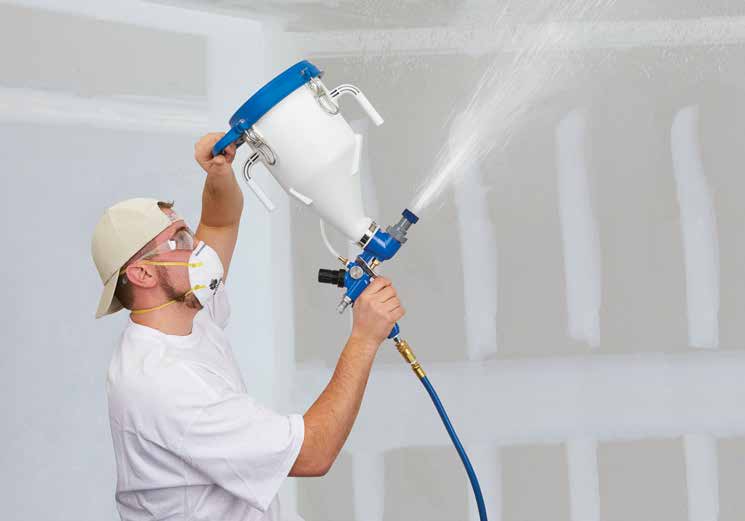Texture Finishes
 Requests for textured drywall surfaces are more common in new construction and remodeling jobs than ever before. While typically applied to ceilings, interior walls are now often included in the texturing process as well. In addition to achieving a desired look, finishing walls with a specific texture finish can help hide blemishes, allowing for easier repairs.
Requests for textured drywall surfaces are more common in new construction and remodeling jobs than ever before. While typically applied to ceilings, interior walls are now often included in the texturing process as well. In addition to achieving a desired look, finishing walls with a specific texture finish can help hide blemishes, allowing for easier repairs.
Each texture finish has unique characteristics, and the most common finishes today are known as ‘knockdown’ and ‘orange peel.’
KNOCKDOWN texture finish is common in new residential construction, especially in the central and southern U.S. It is also a very common finish in remodeling jobs when replacing a prior popcorn finish. In fact, it seems that popcorn texture has been replaced by knockdown texture, even in entry-level home construction, where knockdown once was considered a ‘premium’ finish.
While the term ‘splatter’ may also be used on jobsites, knockdown and splatter texture finishes are essentially the same. However, the unique leather-like look of a knockdown texture is achieved with one extra smoothing step using a drywall knife.
A knockdown texture finish is characterized by a consistent round-droplet pattern on the surface. The droplets can range in size from that of a dime to as large as silver dollars. This texture is typically applied in a medium-density look, allowing the original surface to still show around the droplets. Another desired characteristic is a good ‘reveal,’ or the thickness of the droplet. More is better.
Material consistency for knockdown finishes can range from very loose to very thick. Wall applications tend to call for the thicker material, where the material needs to stay in place and also provide a good reveal. Ceiling mix can also be thick or thin; a thinner mix tends to work best, as it provides a better reveal due to the effects of gravity. A thinner mix also gives you more time to finish the application before the material starts to harden, so you can complete the knockdown smoothing step. Sprayer choice for knockdown is dependent on the desired droplet size and the thickness of material being used. If a large droplet size is the goal, your sprayer will typically need a good flow of heavier material, but little air. On the other hand, if a smaller droplet size is what you want, it will require more air to atomize (although not as much as orange peel). Nozzle sizes for applying a solid, workable knockdown texture finish generally run 6–8 mm for small- to medium-sized droplets, and 10–12 mm for the large droplets.
ORANGE PEEL texture is definitely high on the list when you look at trending residential finishes in new construction. This is especially true in the western and southeast U.S. The cool thing is that the term ‘orange peel’ completely describes the look of the final finish. Genius.
Finishes like orange peel (with small, fine particles) tend to require a lot of air to atomize. This is the rule of thumb with spraying all finishes: the smaller the pattern, the more air required, and vice versa. Finishes in this category also tend to require a very loose-consistency material.
Ideal equipment solutions for this will have high air volume (CFM) and a small nozzle, typically in the 4 mm range.
ACHIEVING A CONSISTENT TEXTURE PATTERN
When applying a texture finish, it is important to achieve consistency across the entire surface. This is especially important for small- or medium-sized remodeling or repair jobs that require matching an existing texture finish. Achieving this comes down to a couple of key elements remaining consistent: material and airflow.
Material consistency
Maintaining uniform material consistency throughout the application is the first step to achieve a uniform pattern. Whether you choose dry powder or ready-mix texture material, both must have the appropriate amount of water added to achieve a specific texture pattern and to provide the best flow—especially when using a hopper gun (shown in the image below).
For jobs requiring more than 5 gallons of material, mixing all you will need for the entire job at one time will help ensure consistency throughout the job. Simply mix and compare batches until they are the same. Combining portions of each mixed batch will further ensure mixture uniformity.
Another factor that can affect material consistency is when, using a gravity-fed hopper gun, the material starts to set while being exposed to air. For small- to medium-sized texture jobs, it’s best to use a pressurized hopper gun with a sealed hopper that seals out air. The added pressure also improves efficiency and provides additional force to project the material farther from the gun to deliver consistent finishes on hard-to-reach surfaces, like high ceilings.
Air Pressure Consistency
The air supply in a texture sprayer also plays a critical role, as there is a direct relationship between the amount of material and amount of air mixing together. As the pattern gets finer, the more air is needed to break the material into smaller pieces. Popular texture finishes such as orange peel and fogging require the most air to break the material into the smallest form.
When using a hopper gun to apply a texture, a separate air compressor is needed, and not all compressors are well-suited for the job. It is critical to have a balance of low and consistent air pressure through the entire hopper of material. To save time and avoid texture pattern inconsistencies, use a continuous-flow air supply system that provides a consistent high CFM air supply at a lower pressure (below 50 psi) throughout the entire job.
CHOOSING THE RIGHT EQUIPMENT
Whether you are adding spray equipment to your fleet, replacing old equipment, or are a first-time buyer, the decisions you make are critical to your bottom line. With the right equipment, you have the best chance to deliver a quality finish and your profits grow. With the wrong equipment, more work will be needed to achieve the desired look, eating into your profits.
Here are 8 considerations to help guide your equipment choices for applying texture finishes:
1.) What materials you typically apply:
- Waterborne, oil-based or high-viscosity materials
- If the material requires high or low atomizing pressure
- How fast the material sets up and dries
- The mil thickness are you trying to achieve
2.) How many gallons are being applied for each job
Properly sizing equipment to the job is the key to productivity. ‘Undersizing’ can be a ‘penny wise, pound foolish’ mistake and results include poor production rate, unwanted component failure, and even work stoppage. In general, larger equipment tends to last longer, and is more productive and more forgiving with materials, aiding in future growth opportunities.
3.) The type of power available at the jobsite
Utilizing the most reliable, convenient and cost-effective power source is key to continued productivity. Equipment solutions are available in various ‘flavors’ including gasoline powered, electric 120v and 240v, and air-powered solutions. Some equipment is even convertible from gas to electric for ultimate versatility. Inside texture finishing work is typically completed with electric units due to abundant free electricity and zero emissions. Besides also running quiet, they offer great performance with materials typically used for interior work.
4.) The types of surfaces being sprayed
Whether you’re spraying drywall, exterior surfaces or concrete, each have their own needs when applying the desired finish. Considering the surface—as well as where the surface is located (overhead vs horizontal vs vertical)—will help you understand tip sizes needed, as well as flow required from a sprayer to support those tips.
Taking this into account will also help you choose the best sprayer and accessories for the job. For example, spraying large vertical walls with a boom lift will probably have different equipment requirements than smaller interior walls and ceilings. Large vertical walls may require extra-wide tips with big orifices, while smaller jobs may not need this extreme. And concrete surfaces may need to be sprayed and back-rolled.
5.) How many spray guns you will use
Typically, most contractors only run a single gun—even on units that can utilize more than one gun efficiently. In circumstances where it is feasible to use multiple guns, doing so can greatly increase productivity without the need for adding another sprayer.
6.) What types of jobs you bid
Whether it’s new construction, remodeling, commercial work or residential work, each job has different requirements and demands. These include differences in crew size, coatings utilized, power available, jobsite conditions, etc. It’s always important to also consider requirements for potential future jobs.
7.) Hose-length requirements
Since it is unproductive to continually move equipment on a jobsite, working with the right length of hose is critical to maximum productivity. Factors affecting hose length include materials being sprayed, tip size, and hose diameter. Ultimately, equipment must have the right pressure and flow specifications to support the hose required to complete the job.
8.) How much you want to spend
Let’s face it, buying a sprayer is an important investment in your business and your livelihood. You want to maximize profit but, to do this, you must also maximize productivity. Selecting the right equipment is critical to ensuring high productivity and higher profits as your business grows.
Set yourself up for success by understanding the importance of material consistency, the unique combination of air and material needed for the particular finish you’re applying—and working with local experts to choose the right equipment to handle the jobs you’re spraying now and for jobs in the future.
_____________________________________________________________________________________________________________________
 Bob Gundersen joined Graco in 1998 and is the global product marketing manager for the company’s texture segment, where he is responsible for developing and implementing marketing product and development plans across the professional texture industry. Graco.com
Bob Gundersen joined Graco in 1998 and is the global product marketing manager for the company’s texture segment, where he is responsible for developing and implementing marketing product and development plans across the professional texture industry. Graco.com




